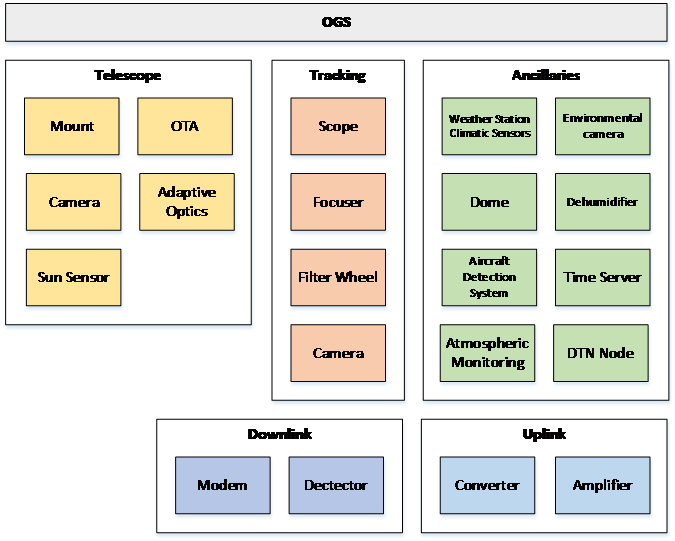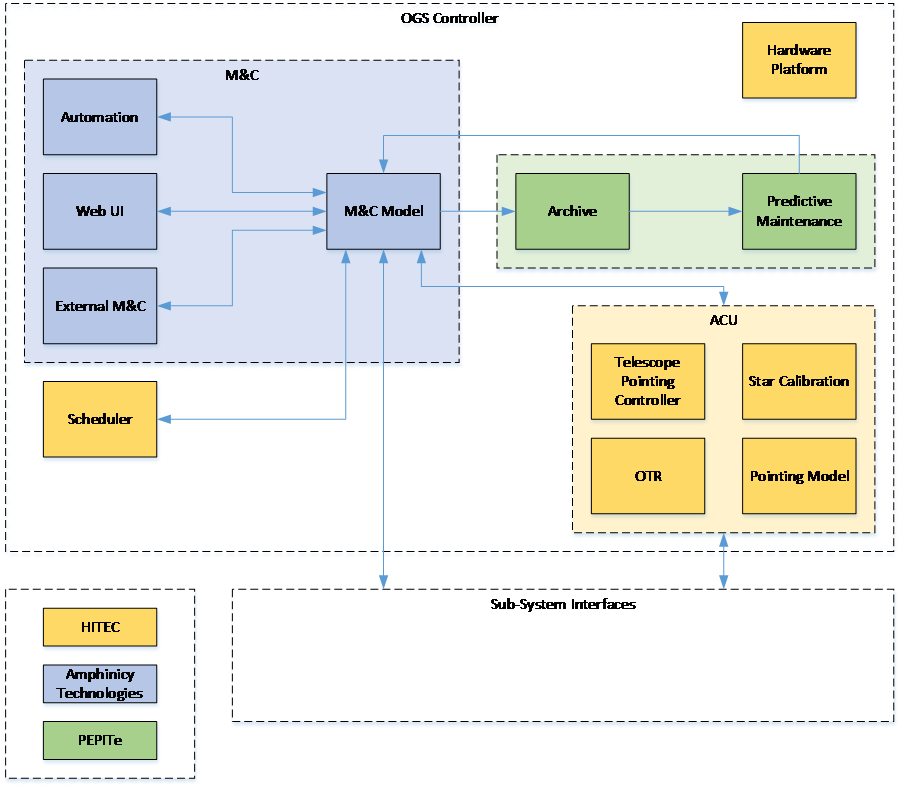-
StatusOngoing
-
Status date2025-01-15
-
Activity Code6B.111
Optical ground stations currently can only be operated and hosted at premises where a technical supervision team is available, as failure recovery does frequently require specialised technicians. This is both intensive in operational expenditures and inhibits the preferential deployment to remote sites where perturbations from ambient light are lower.
This activity aims at replacing the unplanned failure recovery with planned preventive maintenance, complemented with predictive maintenance capability generated by a machine learning process, to anticipate potential failures of the optical ground station and to maximise operational availability of the asset enabled through a central, intelligent ground station controller.
The objective is to design and prototype such a controller, which is a computer control system managing all ground station subsystems and provides quantum key material to the user without the need for technical supervision, thus making the optical ground stations more self-sufficient.
The controller shall be able to interface with all common subsystems of an optical ground station and be able to autonomously execute satellite passes, downlinking data or generating quantum key material without any external connection. To that end maximum use of automation and artificial intelligence shall be made to anticipate, prevent, or correct non-nominal operational states and plan preventive maintenance.
The controller is tested and validated with two different optical ground stations.
The design and prototyping of the computer control system for self-sufficient optical ground stations faces several challenges:
Some uncertainties are linked to the computational power that will be required to run the M&C system and the predictive maintenance algorithms. Furthermore, the suggested simplified hardware platform might lack robustness usually found in enterprise systems and might therefore prove unsuitable for the availability and reliability requirements of the IZN-1 station.
Another unknown is how easily the telescope pointing controller can be interfaced to the different mounts planned to be used for testing. Due to the time-criticality of these interfaces for achieving the required tracking performance, particular care must be taken during the design and development phase.
A further question is the availability of the different telescopes foreseen for the testing. The planning of the activities on these ground stations must be aligned with the scheduling of the present project.
This activity will replace the unplanned failure recovery with planned preventive maintenance to maximise operational availability of the asset, enabled through a central, intelligent ground station controller.
Targeted Improvements: 50% cost reduction of OPEX costs of operational optical ground stations and enabling non-technical users to operate optical ground stations in island mode on their premises and integrate them into their business/data workflows.
One of the primary innovative concepts addressed by the solution is the concept of self-sufficiency, which includes the aspect of autonomy where all major tasks need to be handled (almost) without external connections and the aspect of the station availability covered by the predictive maintenance concept.
The central part of the optical ground station controller is the M&C system which orchestrates the different other subsystems and which provides the main interfaces to the outside world. It includes a Web UI that presents the main information to the user through a browser window. It also provides an M&C interface that allows to connect external SW to the OGS. The automation subsystem of the M&C allows for the configuration and execution of any necessary automation tasks.
The controller also includes a scheduler module that allows to ingest schedule files which describe the temporal sequencing of the passes and which launch a set of events in the M&C system and in the other subsystems that allow to automatically handle the different satellite passes.
The M&C system contains drivers to connect to the telescope pointing controller, a star calibration module and any other subsystems of the telescope, such as the tracking camera, the optical receiver(s), the optical transmitter(s), the modem(s), etc. The telescope pointing controller is the central system handling all motion and tracking related functionalities of the OGS. Throughout the project, it will be connected to the telescope simulator, to the dummy telescope and finally to the reference telescope IZN-1.
Another element of the controller is a star calibration module exchanging a pointing model with the telescope pointing controller.
All relevant optical ground station parameters available to the M&C systems are stored in an archive from which a predictive maintenance system can construct its models.
The different optical ground station controller systems are running on a common hardware platform.
The generic expected structure of an optical ground station expected to be controlled is presented below.

The optical ground station controller will be adaptable to ground stations with various subsystems and capable of evolving alongside them. This includes adjustments to automation, monitoring parameters, and control directives as the optical ground station subsystems develop over time. This process of adapting an optical ground station controller is called ‘tailoring’ and typically involves changes of automation scripts, of the monitoring and control model and of the user interface.
The proposed architecture of the optical ground station controller is presented below:

Milestone 1 - Kick-Off Meeting. Completed on September 5, 2024
Milestone 2 - TBR: Technical Baseline Review. Due Date: First quarter of 2025.
Milestone 3 - CDR: Critical Design Review. Second quarter of 2025.
Milestone 4 - SAT1: Site Acceptance Testing 1. First quarter of 2026.
Milestone 5 – SAT2: Site Acceptance Testing 2. Due Date: Third quarter of 2026.
Milestone 6 - FR: Final Review. Due Date: Fourth quarter of 2026.
-
Contract Signed in July 2024: Advanced payment made.
-
Kick-off meeting on September 5, 2024.
-
Documentation:
-
TN01: Survey and Assessment “State-of-the-Art”: Ongoing
-
CVM: Technical Specification: Ongoing
-




